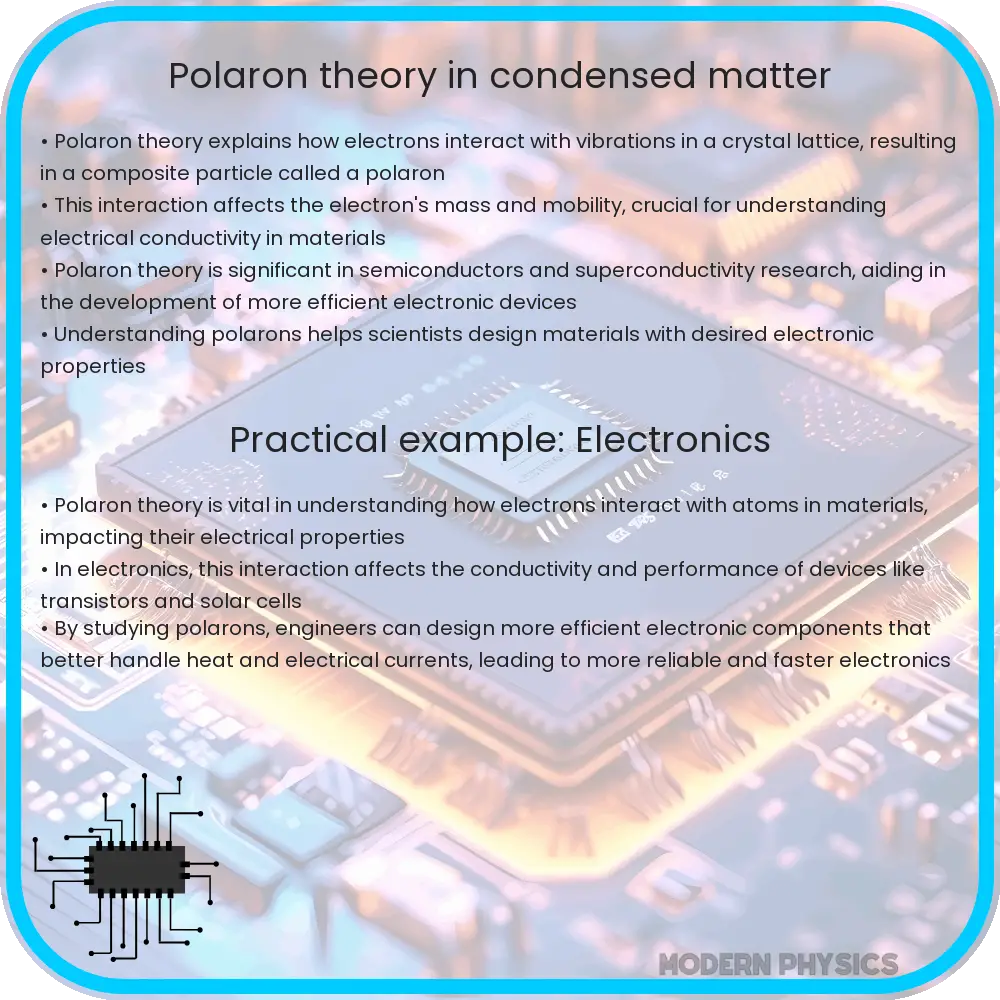In the realm of condensed matter physics, the concept of a polaron emerges as both a profound enigma and a pivotal mechanism behind various physical phenomena. The polaron is not merely a theoretical construct; it embodies the intricate interplay between charge carriers, typically electrons, and the lattice vibrations of a solid material. This engaging subject reveals the complex dance between particles and their environment, beckoning future explorations into its implications for novel materials and quantum states.
To appreciate the significance of the polaron, one must first delve into the foundational aspects of condensed matter physics. This branch of physics, focusing on the behavior of matter in bulk, extends its analysis to the interactions between atoms, electrons, and phonons—the quantized modes of vibrations—in solid-state systems. The emergence of polarons can be understood as a critical consequence of these interactions, illuminating how localized distortions in a lattice can have profound implications for electrical conductivity, superconductivity, and other emergent phenomena.
A polaron is defined as a quasiparticle formed when an electron interacts with the surrounding lattice, resulting in a localized distortion due to the electron’s electric field. This interaction not only modifies the electronic properties of the lattice but also alters the dynamic characteristics of the charge carrier itself. This coupling between an electron and its lattice environment encapsulates a rich tapestry of physics, where the electron becomes wrapped in a ‘cloud’ of phonons—a phenomenon that generates significant alterations in its effective mass and mobility.
The polaron concept can be characterized by two primary types: the small polaron and the large polaron. The small polaron is typically associated with strong electron-phonon coupling and localized lattice distortions. These polarons exhibit a compact structure, where the electron remains strongly correlated with the surrounding phononic cloud, resulting in significant scattering effects and diminished mobility. This behavior manifests in materials at lower temperatures, where the phonon spectrum is largely frozen, thus enhancing electron-phonon interactions.
Conversely, large polarons are characterized by a more delocalized nature. In this case, the electron’s influence extends over a more considerable region of the lattice, leading to lower energy scattering rates. Large polarons typically arise in materials with weaker electron-phonon coupling and become increasingly relevant at elevated temperatures. Their more extended spatial configuration grants them greater mobility, offering intriguing prospects for conduction within various materials.
The implications of polarons extend to an array of phenomena in condensed matter systems, many of which challenge conventional understanding. For instance, polarons play a vital role in charge transport mechanisms, particularly in semiconductors and insulators. The presence of polarons can lead to anomalous resistivity behaviors, vitally influencing how these materials respond to external stimuli, such as electric fields or temperature variations.
Polarons also offer insight into the mechanisms underlying high-temperature superconductivity, a domain notorious for its complexity and lack of comprehensive understanding. Intriguingly, the formation of polarons may facilitate an electron pairing mechanism within certain materials, suggesting that the electron-phonon interactions are not merely background noise but essential players in the quest for superconductivity. As such, polarons provide a promising avenue for exploring new superconducting materials and understanding critical phenomena that arise under extreme conditions.
The study of polarons has further expanded into the realms of multiferroics and quantum spin liquids. In these exotic states of matter, polarons display fascinating interactions with magnetic moments and electronic correlations. Their behavior in these contexts can lead to innovative applications, potentially revolutionizing our grasp of information technology, such as spintronic devices or quantum computing platforms. The tantalizing prospect of manipulating polarons for practical applications encapsulates the excitement of current research, as scientists seek to harness their intrinsic properties.
Furthermore, the theoretical modeling of polarons has evolved significantly, with the advent of advanced computational techniques, such as density functional theory and quantum Monte Carlo methods. These tools allow for deeper insights into the polaron formation mechanisms, helping physicists to predict properties of novel materials with complex lattice dynamics. The intricate calculations involved in this modeling endeavor not only elucidate the characteristics of existing systems but also guide experimentalists toward new frontiers in materials science.
Additionally, investigations into the dynamics of polarons unveil captivating interactions with defects and impurities within a material. As polarons traverse a solid, their interactions are influenced by the presence of imperfections, which can either trap or scatter the polaron. These phenomena underscore the importance of understanding material quality and design in engineering next-generation electronic components.
In conclusion, the study of polarons in condensed matter physics presents a multifaceted perspective on the interactions between electrons and their surrounding environments. Through the lens of polarons, one can appreciate the intricate dance that occurs at the microscopic level—an interplay that resonates through the macroscopic properties of materials. As researchers continue to delve into this captivating subject, the promise of unlocking new technological advancements and enriching our understanding of quantum phenomena remains tantalizingly within reach. The journey into the world of polarons not only piques intellectual curiosity but also hints at the transformative potential awaiting discovery in the vibrant landscape of condensed matter physics.












